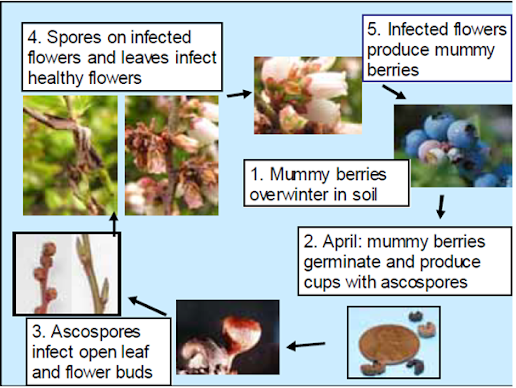The main focus of this post is to update the monilinia blight for the season.
By now, most fields in central NS are beyond the risk of primary Monilinia infection. Primary infection refers to when ascospores infect open leaf and flower buds during the blueberry susceptible stage (above 40% F2 and wetness period; point 3 in Figure 1). In general, if the crops have reached the stage where the leaves have unrolled or the first blossoms are visible, the susceptible period is past and sprays are not required. As you can see from my other posts and updates, as well as your observation from fields, we are around 10% to 50% of blooms in the province depending on your area. However, the best indicator would be if apothecia cups still produce spores. We didn’t have mummy berry plots to monitor apothecia cups in wild blueberries, but reports from highbush blueberries showed that all apothecia cups were dried up in the Annapolis Valley area. Thanks to Sonny Murray’s report. Therefore, we are expecting the same development trend in lowbush blueberry fields. We got a lot of heat over the last few days, and it was dry over the last few days as well. This is helpful to dry up apothecia cups. Most apothecia cups will dry up by now.
Figure 1. Monilinia Blight Infection Cycle
Cape Breton is still under infection period as fields are just beyond the 40% F2 threshold. Growers in the area should still pay attention to their plant development and weather forecast.
This year, most
growers were able to get through the monilinia season with 1-2 applications. If
fields have a primary infection, symptoms will show up on leaves and flowers
and symptoms will start to show over the next week or so (Figures 2&3, photos
from 2021). We encourage growers to check their fields and note if there are
infections that occur in their fields. This would help growers to evaluate
their application program and determine better application timings and choose products
for next season.
Figures
2&3 Monilinia blight infection on flowers (top) and leaves (bottom), photos from 2021
Secondary infection (point 4 in Figure 1) refers to when infected tissues from the primary infection period produce conidia and those spores move to other healthy flowers and cause infection which will end up producing mummy berries as plant development continues. This phase is impossible to control so the primary infection period control becomes extremely important. If you observe primary infection symptoms in your field, it is good to mark the area and before harvest, collect those mummy berries to prevent future season infection.
As I mentioned in the last update, during bloom time, growers should start to arrange bees and potential botrytis blight control if your fields are prone to this disease.
Have a great long weekend!
Hugh



